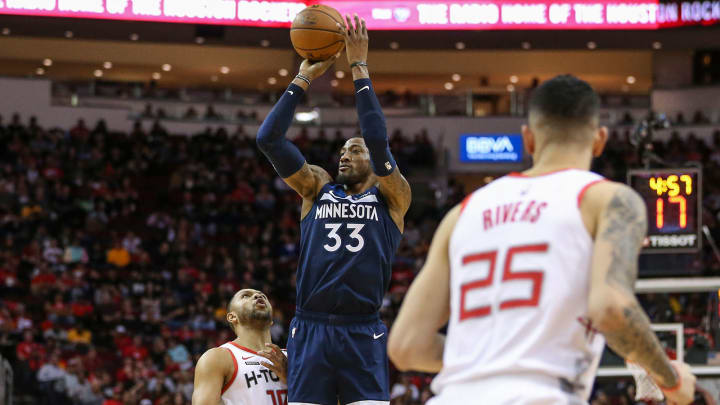The Rockets Are Reaching Their Platonic Ideal

One of my biggest pet peeves is when an NBA player (or really anyone) does something ridiculous and then they are described as being “a video game.” This is almost always not the case. Video games in 2020 go so far out of their way to be accurate and realistic that they make it damn near impossible to do some of the wild stuff you see in real life. Steph pulling up from the logo for that shot against OKC? Not really happening in 2K. The Block? Even less likely. If anything, we should be appreciating players and the ridiculous highlights they pull off specifically because they can’t even be dreamed up as possible in a simulation of their reality.
I say all of this to make my next point: Th Rockets are kind of becoming a video game! Houston is (reportedly) involved in a four-team trade that will jettison center Clint Capela in exchange for three-and-D specialist Robert Covington. As of early Wednesday afternoon, the trade is not final, and there could be more moving parts, but the gist is that the Rockets are moving on from their 25-year-old big man for a 29-year-old perimeter player. Now, shooing aside your center and playing five guys who can jack up threes? That’s something kids have been doing in video games for years.
In the immediate aftermath of the trade, the Rockets’ remaining centers are 37-year-old Tyson Chandler and Isaiah Hartenstein, the latter of whom is most famous for being nutmegged by Chris Paul this season. Even if Houston follows through on its plans to add another center via trade or on the buyout market, it’s obvious the Rockets are prioritizing the idea of playing small, switchy lineups. A potential starting five of James Harden, Russell Westbrook, Eric Gordon, Covington, and P.J. Tucker should have just enough defensive juice to keep things interesting on that end of the floor, while offensively there will be several possessions in which no one steps inside the three-point line.
This style makes some sense for the Rockets. Westbrook’s lack of outside shooting can make him a tricky fit with non-stretchy fives (especially when he’s playing off the ball.) Russ and Capela had a meager 2.2 net rating as a duo. Tucker is burly (and and wild) enough to play extended minutes against seven-footers. And Houston had its most success defensively a couple of seasons ago, when it could switch literally everything against the Warriors. (Seriously, go back and watch how quickly the Rockets would switch even if two players simply walked by each other from the wing to the corner. I still love the Tuckwagon!)
But make no mistake: This is about offense. The Rockets are making perhaps their biggest bet yet on the value of threes over twos. Maybe Houston will get another pick-and-roll partner for Harden and Westbrook. But that player almost certainly won’t be who they close with. Daryl Morey & Co. are gambling they can overcome potential rebounding deficiencies and post vulnerabilities with pure shooting. The Rockets are willing to let Tucker bang with guys like Anthony Davis and Nikola Jokic if it means they can trade those post-ups for threes on the other end of the floor. Houston has obviously always played like this to an extent, but trading Capela means no longer having the security blanket of a wildly competent big who was unselfishly willing to set screen after screen for his guards while also playing quality defense against high-profile centers.
There are a couple of undercurrents to the Capela trade. If the Rockets are in fact trying to make moves in part to duck the luxury tax, that’s wack as hell. Teams should never be celebrated for fancy maneuvering to save money, an oft-harmful side effect of asset twitter. I’ll give Houston the benefit of the doubt for now, because moves can still be made. But if this team really cost cuts like it did in the summer of 2018, owner Tilman Fertitta should make like his team’s offense and stop clogging the paint, because multibillionaires shouldn’t be penny pinching title contenders.
Moving Capela is also somewhat of a sad commentary on the state of the middle-class NBA center. The Rockets are probably guessing they can get 80% of Capela’s production at a much smaller percentage of the cost. Hypothetically, wouldn’t teams rather pay someone like Aron Baynes $5.4 million and spend $10 million on another wing as opposed to nearly $15 million on Capela alone? I love Capela and he’s been an outstanding team player, but that’s the unfortunate reality of his position.
In a salary cap league, paying centers will mostly be a tricky proposition unless they’re Jokic or Embiid types. Most teams finish with a power forward–y type at the five these days, and paying a premium for a rim-runner when guys like Dwight Howard or Javale McGee are frequently available at a discount appears to be less-than-ideal business. Unless a center is one of the best in the game (Jokic, Embiid, Rudy Gobert) or can keep the lane clean (Brook Lopez), they’ll probably get caught in the churn at some point (sorry, Montrezl Harrel.)
Anyway, this trade is really about the Rockets, who want to do the things NBA teams usually do for only a few minutes at a time for basically a whole-ass game. I respect Houston’s commitment to ignoring social conventions and putting its best five players on the floor regardless of height or decades of agreed-upon positions. With Capela gone (and even with some lesser guy likely coming to take his place) the Rockets are seemingly going aller inner than ever on their singular style of chucking threes like there’s no tomorrow. Time (or more accurately, the postseason) will tell if it’s a strategy that belongs in real life.

Rohan Nadkarni covers the NBA for SI.com. The Mumbai native and resident fashion critic has written for GQ.com, Miami Herald and Deadspin.